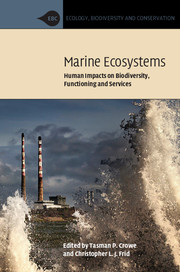Book contents
- Frontmatter
- Contents
- List of contributors
- Part I Key concepts
- 1 Introduction
- 2 Ecosystem services and benefits from marine ecosystems
- 3 Assessing human impacts on marine ecosystems
- 4 Modifiers of impacts on marine ecosystems: disturbance regimes, multiple stressors and receiving environments
- 5 Impacts of changing biodiversity on marine ecosystem functioning
- Part II Impacts of human activities and pressures
- Part III Synthesis and conclusions
- Index
- Plate Section
- References
1 - Introduction
from Part I - Key concepts
Published online by Cambridge University Press: 05 June 2015
- Frontmatter
- Contents
- List of contributors
- Part I Key concepts
- 1 Introduction
- 2 Ecosystem services and benefits from marine ecosystems
- 3 Assessing human impacts on marine ecosystems
- 4 Modifiers of impacts on marine ecosystems: disturbance regimes, multiple stressors and receiving environments
- 5 Impacts of changing biodiversity on marine ecosystem functioning
- Part II Impacts of human activities and pressures
- Part III Synthesis and conclusions
- Index
- Plate Section
- References
Summary
Marine ecosystems
The Earth is a blue planet. Seas and oceans cover over 70% of the Earth's surface and, with an average depth of over 3.2 km, the total volume of marine ecosystems is vastly greater than that of terrestrial and fresh-water environments combined, comprising 98% of the total inhabitable space on the planet (Speight and Henderson, 2010). Marine ecosystems contain 31 of the 33 phyla of animals, each of which constitutes a unique and distinctive body plan, with 15 of those phyla occurring only in the sea (Angel, 1993). Approximately 250 000 marine species have been described, with an estimated 750 000 still to be discovered (Census of Marine Life, 2010). Marine creatures include the largest ever to live (blue whales), yet the energy to fuel these giants is mainly captured by microscopic plankton, rather than more substantial plants, one of a number of fundamental differences between marine and terrestrial ecosystems (Steele, 1985, 1991; Webb, 2012). Of the global annual net primary productivity, approximately 104.9 petagrams (1015 grams) of carbon per year, around half is produced by marine ecosystems (Field et al., 1998). Although coral reefs and beds of seaweed are, per unit area, among the most diverse and productive ecosystems on Earth, open oceans have levels of productivity akin to terrestrial deserts because life is so thinly spread, but nevertheless make the single greatest contribution to global productivity because of their size (Whittaker and Likens, 1975).
Archaeological records show that even the earliest humans exploited the marine environment for food, as a medium for transportation and as a repository for waste (Jackson, 2001; Jackson et al., 2001). Today, the marine environment provides approximately 80 million tonnes per year of fish and shellfish from capture fisheries, representing about 3% of our global animal protein supply. Marine aquaculture contributes an additional 20 million tonnes (FAO, 2012). Therefore, marine ecosystems can be seen as having an important role in global food security (Frid and Paramor, 2012).
- Type
- Chapter
- Information
- Marine EcosystemsHuman Impacts on Biodiversity, Functioning and Services, pp. 3 - 20Publisher: Cambridge University PressPrint publication year: 2015



